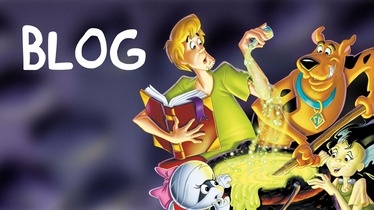|
A few episodes of Scooby-Doo! Mystery Incorporated and Be Cool, Scooby-Doo! had the wrong titles listed by TV providers. These include:
39 Comments
In "Aliens Among Us" from Scooby-Doo! Mystery Incorporated, the coordinates given for the grave in Gatorsburg are "34 11 15N, 118 20 46W." Typing the address into Google Earth shows that in real life, these coordinates geolocate to 3300 West Pacific Avenue in Burbank, California. This is the address of a Warner Brothers studio, which can be found on the studio's official website here.
Series producer and head writer Mitch Watson also clarified in an interview from the Unmasked History of Scooby-Doo podcast that the coordinates are Sam Register's office, and that it was an intentional Easter egg they hoped fans would uncover (Thanks to Ed for the link). In "Grim Judgment" from Scooby-Doo! Mystery Incorporated, Brad and Judy's show Sternum to Sternum is a parody of a real-life mystery show called Hart to Hart. The show ran from 1979-1984. Hart to Hart was created by Sidney Sheldon, who is most famous for creating I Dream of Jeannie - featuring the same Jeannie whom Scooby and the gang met in "Mystery in Persia" from The New Scooby-Doo Movies.
In 1985, ABC created a Star Wars special to preview their upcoming slate of shows for the fall television season. Among these was The 13 Ghosts of Scooby-Doo, and at 13:06 in the video above, C-3PO, R2-D2 and Tony Danza come across a real-life Chest of Demons on an adventure. The clip is about a minute and a half in length.
In addition, Scooby's first team-up with Weird Al Yankovic was actually not "Bat-Mite Presents: Batman's Strangest Cases." On a similar note, for their 1984 television preview, ABC created a bumper involving Scooby and Scrappy meeting Weird Al at Knott's Berry Farm. During the bumper, Weird Al, Scooby and Scrappy preview the new shows on ABC's 1984 fall schedule. You can watch the video here. A big thanks to Juan for finding these cool bumpers and sharing them with me! Despite being two seasons, The Richie Rich / Scooby-Doo Show took less than a year to air both of them, making it the shortest multi-season Scooby-Doo series to date. Season 1 premiered on November 8, 1980, and the season 2 finale aired on October 31, 1981. This is because in 1980, similarly to last year, there was a large SAG-AFTRA strike that delayed the start of the 1980 television season. The strike lasted just over three months, from July 21 through October 23, 1980. Because lines for the season were not finished being recorded yet, The Richie Rich / Scooby-Doo Show was not completed, and thus could not be aired in September when the television season normally began. 67,000 actors went on strike during this time, due to a dispute in which actors felt the residuals they received for home media releases (mainly VHS tapes, at the time) was unfair. Before last year's SAG-AFTRA strike, this 1980 strike was previously the longest actors' strike in history.
On a whim the other day, I decided to watch "Riva Ras Regas" from What's New, Scooby-Doo? and was inspired to listen to Lindsay Pagano's debut album for the first time ever afterwards, since I'd not checked out any of her music outside of the show. As you may also know, I also chatted with Lindsay several years ago, who was super nice, and was kind enough to guest-write the 300th fun fact for the blog. For today's fun fact, I was inspired to do some research into Lindsay's music career before and after her appearance in What's New, since I realized I didn't really know all that much about it.
Lindsay was inspired to pursue music as a career because her parents were in a band, which she mentions in an interview with MTV. She mentions that a pivotal moment for realizing she was interested in becoming a singer was after winning a talent show in fifth grade, where she sung "Hero" by Mariah Carey (who is Lindsay's favorite artist). At her 13th birthday party, Lindsay sang three songs for her friends. A family friend video taped the performance, and sent it to Jude Cole, who loved Pagano's voice, and signed on as her songwriter and producer. Lindsay's career started in 2001 when she was 15, and she was quickly launched into popularity through her song "Everything U R" being used in an AOL commercial, as well as appearing on the soundtrack for the American Pie 2. She became known as the "AOL Girl" due to her song being used in the commercial. She also appeared in a number of ads for Reebok. As previously mentioned in Fun Fact #301, "Everything U R" also became the theme song for the NBC sitcom Maybe It's Me. She released her debut album in 2001, which was titled Love & Faith & Inspiration. The album featured 11 tracks, one of them being an extended reprise of the title track at the end. During the album's development process, Lindsay was introduced to Paul McCartney of The Beatles, who also enjoyed her music. McCartney would later offer to remake his 1983 song "So Bad" for her, and perform it as a duet with Lindsay on the album (you can listen to their song together here). In 2002, as Lindsay shared in the 300th fun fact, she guest-starred in "Riva Ras Regas" after her label approached her with the suggestion to appear in What's New, Scooby-Doo?, as a way to get her name out there. Lindsay was 16 at the time of guest starring in the episode. This was a common strategy that Warner Brothers seemed to be piloting with their artists during the time that What's New, Scooby-Doo? aired, as is evident by other new musical acts appearing in episodes, including Simple Plan in "Simple Plan and the Invisible Madman" and Smash Mouth appearing in "Reef Grief." Also during that year, Lindsay went out on tour with singer Aaron Carter to promote her album. Lindsay mentioned in an interview (the clip is 1:03:30 - 1:04:50) that the songs she sings in "Riva Ras Regas" were not real songs in her discography, and were written by the show's writers. Moreover, full versions of these songs were never made. Lindsay recorded only the parts that appeared in the episode. She released a single in 2004 titled "Bang!" but her label ended up shutting down and changed management. She mentioned in an interview that she felt her and and the label's new management had creative differences, so she decided to part ways with the label. As a result, the song is also no longer available for download anywhere, and became lost media (in my research, I found there are a number of Reddit threads of people trying to find it). In 2009, Lindsay released two singles exclusively to YouTube, including "I Gotta Stop" (which was sent to radio) and "Three Wishes." These were the last official songs she released to date. In 2014, Lindsay would become a contestant the hit TV show The Voice. Shakira chose Lindsay to be on her team, but Lindsay was eliminated after three episodes. Although Lindsay has not officially released any other music, she continues to perform live in small venues. This was a bit of a different style of fun fact than the typical, so I hope you enjoyed it! Also, it's Lindsay's birthday on Saturday, so happy early birthday to her! According to Sunisa Petchpoo's LinkedIn page, several of the Scooby-Doo specials and films from 2013 and 2014 originally were given different titles. Spooky Scarecrow was originally titled Scooby-Doo and the Scarecrow's Curse, Mecha Mutt Menace was titled Maniacal Mecha Mutt, and FrankenCreepy was titled Curse of the Frankencreep. In addition, Jason Wyatt's LinkedIn page mentions that Ghastly Goals was merely titled Goal.
A few of the "previously on" segments from Scooby-Doo! Mystery Incorporated appear to have had the original scenes re-animated rather than showing the same animation again. There are a few notable differences between the original scenes and the recaps:
Perhaps one of the infamous type of Scooby-Doo villains are sheet ghosts, particularly the ones in "Hassle in the Castle" and "Haunted House Hang-Up." Contrary to what you might think about sheet ghosts merely being a budget-effective way to depict a ghost, there is actually some lore behind why ghosts are depicted as wearing sheets over their heads according to KQED. Until the 19th century, the dead were often wrapped in a sheet by their family and buried as memorials, rather than being put in coffins. In addition, in those days, people who believed they had a supernatural sighting would often report sheets floating by themselves.
In the original script for "The Curse of Kaniaku" from Be Cool, Scooby-Doo!, instead of being happy about going viral in the Japanese media, head writer Jon Colton Barry shared that the plot was supposed to be the opposite. Originally, Daphne was against the attention she was receiving, because she felt it took away from her uniqueness having everybody else be like her.
|
AuthorWildwindVampire Categories
All
Archives
July 2024
|













 RSS Feed
RSS Feed
